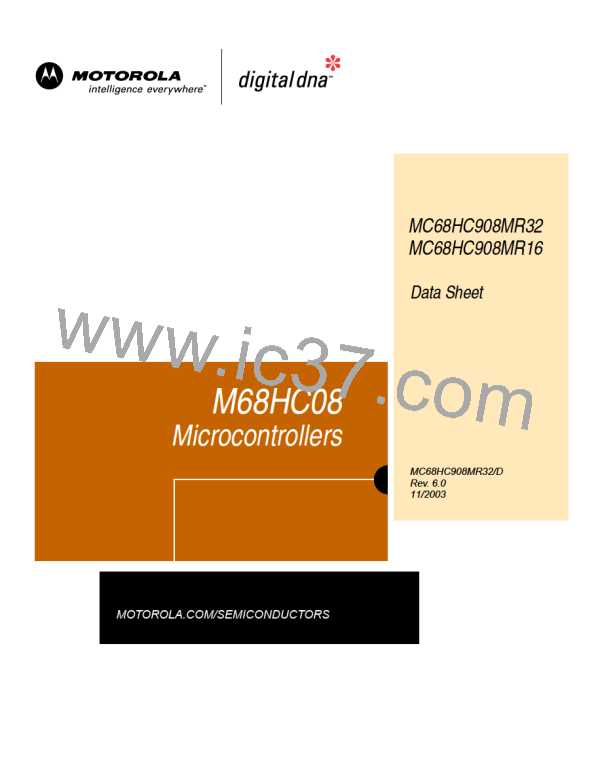Timer Interface A (TIMA)
16.3.4.2 Buffered PWM Signal Generation
Channels 0 and 1 can be linked to form a buffered PWM channel whose output
appears on the PTE4/TCH0A pin. The TIMA channel registers of the linked pair
alternately control the pulse width of the output.
Setting the MS0B bit in TIMA channel 0 status and control register (TASC0) links
channel 0 and channel 1. The TIMA channel 0 registers initially control the pulse
width on the PTE4/TCH0A pin. Writing to the TIMA channel 1 registers enables the
TIMA channel 1 registers to synchronously control the pulse width at the beginning
of the next PWM period. At each subsequent overflow, the TIMA channel registers
(0 or 1) that control the pulse width are the ones written to last. TASC0 controls and
monitors the buffered PWM function, and TIMA channel 1 status and control
register (TASC1) is unused. While the MS0B bit is set, the channel 1 pin,
PTE5/TCH1A, is available as a general-purpose
I/O pin.
Channels 2 and 3 can be linked to form a buffered PWM channel whose output
appears on the PTE6/TCH2A pin. The TIMA channel registers of the linked pair
alternately control the pulse width of the output.
Setting the MS2B bit in TIMA channel 2 status and control register (TASC2) links
channel 2 and channel 3. The TIMA channel 2 registers initially control the pulse
width on the PTE6/TCH2A pin. Writing to the TIMA channel 3 registers enables the
TIMA channel 3 registers to synchronously control the pulse width at the beginning
of the next PWM period. At each subsequent overflow, the TIMA channel registers
(2 or 3) that control the pulse width are written to last. TASC2 controls and monitors
the buffered PWM function, and TIMA channel 3 status and control register
(TASC3) is unused. While the MS2B bit is set, the channel 3 pin, PTE7/TCH3A, is
available as a general-purpose
I/O pin.
NOTE:
In buffered PWM signal generation, do not write new pulse width values to the
currently active channel registers. User software should track the currently active
channel to prevent writing a new value to the active channel. Writing to the active
channel registers is the same as generating unbuffered PWM signals.
16.3.4.3 PWM Initialization
To ensure correct operation when generating unbuffered or buffered PWM signals,
use this initialization procedure:
1. In the TIMA status and control register (TASC):
a. Stop the TIMA counter by setting the TIMA stop bit, TSTOP.
b. Reset the TIMA counter and prescaler by setting the TIMA reset bit,
TRST.
2. In the TIMA counter modulo registers (TAMODH–TAMODL), write the value
for the required PWM period.
Data Sheet
242
MC68HC908MR32 • MC68HC908MR16 — Rev. 6.0
Timer Interface A (TIMA)
MOTOROLA

 FREESCALE [ Freescale ]
FREESCALE [ Freescale ]